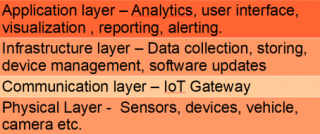Those who have heard of IoT , would have also heard of IoT platform. There are lot of IoT platforms available now & it is keep growing year or year.
IoT platform is a key component in IoT ecosystem . In this post i would try to provide the explanation on IoT platform as simple as possible.
First we should re-collect the components of IoT system to understand IoT platform. To know more about what is IoT or what is Internet of Things ,I have covered the details in my previous blog what is IoT.
The major components of IoT systems are Sensors/devices , Connectivity, data processing & user interface.
The sensors & devices collect data from environment or perform the actions like temperature reading, location tracking, moisture data etc.To send these data to data processing there should be a medium .The data will be send mainly to cloud ( what is cloud ? i will submit some blog for this in future) & receive from cloud back to the devices. In IoT system these are mainly done through gateways.
To make this user friendly , there is a need for a user interface or software that can be used to interact with IoT systems , example a web dashboard which shows the trend of the data analyzed, button to control the devices like switching of light, park vehicle etc.
Definition for IoT platform:
IoT platforms are the support software that connects everything in an IoT system. An IoT platform facilitates communication, data flow, device management, and the functionality of applications.
we can say IoT platform is a multilayered technology, that connects the sensors/devices, provision them, manage them & can automate the connection of the devices in the Internet of Things. With IoT platform its easy to connect to the devices to the cloud & data processing. It connects remote devices to user applications and manages all the interactions between the hardware and the application layers.
Some of the main common features of IoT platforms are,
- Registry for recognizing devices
- Software Development Kit for devices
- Device Shadows
- Secure Device Gateway
- Rules engine for inbound message evaluation
IoT Architecture:
We could say there are 4 layers in an IoT stack
- Physical
- Communication
- Infrastructure
- Application
Your devices connect to the platform, which sits in the cloud or in your on-premises data center, either directly or by using an IoT gateway. There are multiple protocols used for communication , refer the link IoT Standards and Protocols for more info.
The IoT platform itself can be decomposed to multiple layers
- Infrastructure
- Communication
- Core features ( Data collection, Device management, Configuration management, messaging, Software updates etc.)
Advantages of IoT platform:
- scalable ( Easily able to add more end points or devices)
- customizable (Easily modify to the business need & add more features)
- secured ( Encryption & data security)
- User friendly ( GUI or good user interfaces)
Some of the major IoT platforms are listed below
- Google Cloud IoT
- AWS IoT Core
- Microsoft Azure IoT
- IBM Watson IoT
- Bosch IoT Suite
- Dell IoT
- Salesforce IoT
- Oracle IoT cloud platform
Above has given you IoT Platform companies list , To more about Top IoT platform Companies features refer http://www.thetips4you.com/iot-platform-companies/
There are free IoT platforms available also like
- Cayenne ( I have used this for lot of my projects, will share more in upcoming blogs on how to do the IoT projects with Cayenne)
- Thingsboard
- Blynk
These are opensource IoT platforms & most of these platforms provide API to support the Linux hacker board such as Raspberry Pi, Arduino.
We get a easy user interfaces to add the devices, customize the action to be done with the devices, connect to respective GPIO Pin of the raspberry or Arduino. Most of the necessary features are inbuilt in the IoT platforms, we make use of those to build our home projects. Simply add a relay button in Cayenne connect to your respective GPIO pin with a toggle switch so you can control the lights connected to the relay.
Refer the posts to know more about IoT sensors and IoT Devices .
